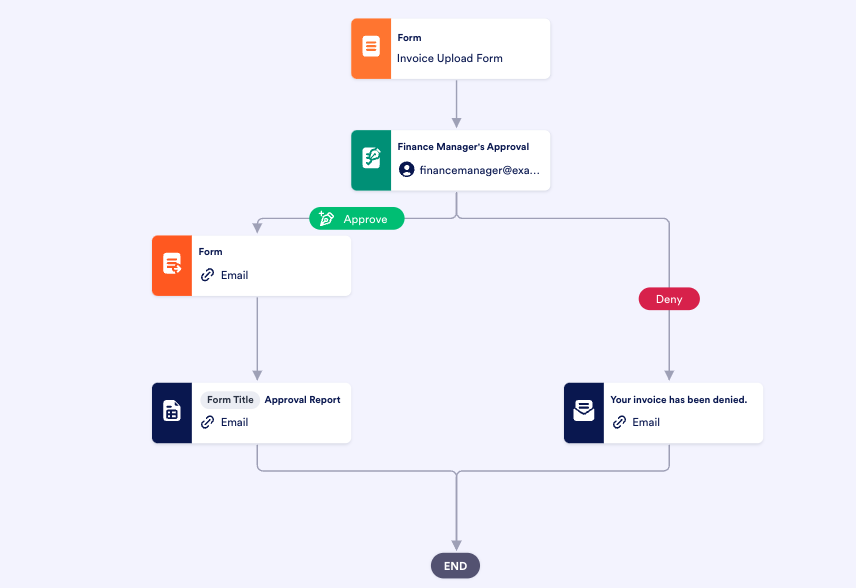Approval workflows are vital processes for companies. They play a role in everything from paying invoices to launching new products and marketing campaigns. Following approval workflow protocols ensures an organization protects its funds, resources, reputation, and even its standing with the law.
For example, an employee’s request to take time off may involve a simple, straightforward approval workflow:
- The employee submits the request.
- A single manager reviews the request and approves or denies it based on employee eligibility.
However, not all approval processes are this painless. Instead, they can become incredibly complex for larger projects, requiring input and oversight from numerous departments and stakeholders. How do teams remain clear about who needs to grant approvals on specific projects and stages?
That’s where an approval matrix comes in.
What’s an approval matrix?
In most organizations, there are several decision-makers and stakeholders who ensure that everyone follows business processes correctly and quality work advances to completion. These decision-makers may be managers, department heads, or C-suite executives. Organizations typically have rules in place regarding who has authority over different projects.
An approval matrix, also known as a “schedule of authority,” is a visual representation of these rules. It clearly designates who’s in charge of approving what and when. This prevents confusion about how to route tasks and keeps an approval workflow running as efficiently as possible.
Examples of an approval matrix
An approval matrix can illustrate decision-making authority for any workflow with conditional or multi-level approvals. A matrix is often made up of grids with axes that juxtapose decision-makers with the conditions over which they have authority.
Here are some examples of common approval matrices:
Purchase approval

It’s common for organizations to assign approval authority for purchases and other expenditures based on the amount of money involved. Typically, higher dollar amounts require approval from higher-ranking executives.
A purchase approval matrix works best when it lists decision-makers in order of their rank in the hierarchy, with another axis that delineates differing approval conditions. This matrix can also illustrate the chain of approval.
For example, in the example above, the board of directors may have final approval on expenditures over $100,000, but that request will have to make its way up the chain with approvals by every level of authority below.
New project approval

In many organizations, one project may involve multiple departments and teams. Depending on a team member’s expertise or resource availability, it may be important for multiple people to give their approval for a project.
This type of approval workflow usually doesn’t involve a hierarchy, where approval by one executive moves a workflow up the chain of command for further review. Instead, it features a parallel process, where multiple decision-makers review a request at the same time to reach a consensus decision.
In this case, an approval matrix can illustrate the types of projects that each decision-maker will be in charge of reviewing.
Content approval

Content approval workflows ensure stakeholders who have the most expertise on a subject review the content an organization publishes. However, as projects become diversified, not all stakeholders will need to review each piece of content.
In the content approval matrix above, the top axis lists decision-makers from left to right in order of authority. The first “x” in each row illustrates who should review the first draft, while the last “x” on the right indicates who gives final approval.
How do you design an approval matrix?
An approval matrix is straightforward and simple to create, as long as you’re familiar with your organization’s rules and hierarchies.
Remember to focus an approval matrix on one type of workflow — otherwise, it might get a little convoluted.
For example, don’t create an approval matrix that shows both a budget approval hierarchy and a marketing campaign approval hierarchy. The workflow may involve so many different decision-makers and conditions that the matrix is impossible to make.
And, if you do manage to design something that looks like an approval matrix, it may be unnecessarily complicated and defeat the purpose of the visual aid.
Here’s how to design an approval matrix:
1. List the conditions that determine the approval workflow
When it’s clear what type of workflow you’re designing the approval matrix for, on one axis of the table, list all of the conditions that will determine who you’ll route an approval to. For example, if it’s a budget approval, are the conditions based on the amount of the proposed budget? Or does it depend on the department or project?
2. List the decision-makers
Review the rules of your organization to determine which decision-makers are necessary for a workflow, and then list them in the other axis of the table. Don’t include any decision-makers who are unrelated to the conditions on the first axis — the table may look overcrowded or incomplete.
3. Organize the information
With the same principle in mind as when you’re making a scatter chart, plot a point at the intersection of each condition and the decision-maker who has approval authority over it. Where it makes sense, rearrange the list of decision-makers according to the hierarchy of authority.
Streamline multi-level approvals with Jotform
Approval matrices are great visual aids for understanding approval workflows. And digital workflow management platforms like Jotform can help you execute approval workflows more efficiently.
After all, the foundation of each workflow is a collection of forms. Jotform makes it simple to build efficient approval workflows, speeding up projects and reducing stress — for free. With Jotform Approvals, you can easily track invoices, manage approvals for various projects, and even collect signatures.
Users can streamline every workflow in their business with greater transparency, efficiency, and collaboration. You can create multi-level approval flows and even dynamic approval flows, all with less effort.
Are you ready to put your approval matrix knowledge to the test?






























Send Comment: